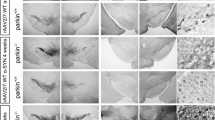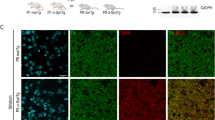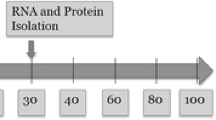Abstract
Parkinson's disease (PD) is a severe neurodegenerative disorder characterised by loss of dopaminergic neurons of the substantia nigra. The pathological hallmarks are cytoplasmic inclusions termed Lewy bodies consisting primarily of aggregated α-synuclein (αSN). Different lines of transgenic mice have been developed to model PD but have failed to recapitulate the hallmarks of this disease. Since treatment of rodents with the pesticide rotenone can reproduce nigrostriatal cell loss and other features of PD, we aimed to test chronic oral administration of rotenone to transgenic mice over-expressing human αSN with the A53T mutation. Initial assessment of this transgenic line for compensatory molecular changes indicated decreased brain β-synuclein expression and significantly increased levels of the PD-associated oxidative stress response protein, DJ-1, and the E3 ubiquitin ligase enzyme, Parkin. Rotenone treatment of 30 mg/kg for 25 doses over a 35-day period was tolerated in the transgenic mice and resulted in decreased spontaneous locomotor movement and increased cytoplasmic αSN expression. The mitochondrial Parkinson's-associated PTEN-induced kinase 1 protein levels were also increased in transgenic mouse brain after rotenone treatment; there was no change in brain dopamine levels or nigrostriatal cell loss. These hA53T αSN transgenic mice provide a useful model for presymptomatic Parkinson's features and are valuable for study of associated compensatory changes in early Parkinson's disease stages.






Similar content being viewed by others
References
Anderson JP, Walker DE, Goldstein JM, de Laat R, Banducci K, Caccavello RJ, Barbour R, Huang J, Kling K, Lee M, Diep L, Keim PS, Shen X, Chataway T, Schlossmacher MG, Seubert P, Schenk D, Sinha S, Gai WP, Chilcote TJ (2006) Phosphorylation of Ser-129 is the dominant pathological modification of alpha-synuclein in familial and sporadic Lewy body disease. J Biol Chem 28140:29739–29752
Baba M, Nakajo S, Tu PH, Tomita T, Nakaya K, Lee VM, Trojanowski JQ, Iwatsubo T (1998) Aggregation of alpha-synuclein in Lewy bodies of sporadic Parkinson's disease and dementia with Lewy bodies. Am J Pathol 1524:879–884
Betarbet R, Sherer TB, MacKenzie G, Garcia-Osuna M, Panov AV, Greenamyre JT (2000) Chronic systemic pesticide exposure reproduces features of Parkinson's disease. Nat Neurosci 312:1301–1306
Betarbet R, Canet-Aviles RM, Sherer TB, Mastroberardino PG, McLendon C, Kim JH, Lund S, Na HM, Taylor G, Bence NF, Kopito R, Seo BB, Yagi T, Yagi A, Klinefelter G, Cookson MR, Greenamyre JT (2006) Intersecting pathways to neurodegeneration in Parkinson's disease: effects of the pesticide rotenone on DJ-1, alpha-synuclein, and the ubiquitin-proteasome system. Neurobiol Dis 222:404–420
Braak H, Del Tredici K, Rub U, de Vos RA, Jansen Steur EN, Braak E (2003) Staging of brain pathology related to sporadic Parkinson's disease. Neurobiol Aging 242:197–211
Casari G, De Fusco M, Ciarmatori S, Zeviani M, Mora M, Fernandez P, De Michele G, Filla A, Cocozza S, Marconi R, Durr A, Fontaine B, Ballabio A (1998) Spastic paraplegia and OXPHOS impairment caused by mutations in paraplegin, a nuclear-encoded mitochondrial metalloprotease. Cell 936:973–983
Clark IE, Dodson MW, Jiang C, Cao JH, Huh JR, Seol JH, Yoo SJ, Hay BA, Guo M (2006) Drosophila PINK1 is required for mitochondrial function and interacts genetically with Parkin. Nature 4417097:1162–1166
Colapinto M, Mila S, Giraudo S, Stefanazzi P, Molteni M, Rossetti C, Bergamasco B, Lopiano L, Fasano M (2006) alpha-Synuclein protects SH-SY5Y cells from dopamine toxicity. Biochem Biophys Res Commun 3494:1294–1300
Culvenor JG, McLean CA, Cutt S, Campbell BC, Maher F, Jakala P, Hartmann T, Beyreuther K, Masters CL, Li QX (1999) Non-Abeta component of Alzheimer's disease amyloid (NAC) revisited. NAC and alpha-synuclein are not associated with Abeta amyloid. Am J Pathol 1554:1173–1181
Forno LS, Langston JW, DeLanney LE, Irwin I (1988) An electron microscopic study of MPTP-induced inclusion bodies in an old monkey. Brain Res 4481:150–157
Gasser T (2005) Genetics of Parkinson's disease. Curr Opin Neurol 184:363–369
George S, van den Buuse M, San Mok S, Masters CL, Li QX, Culvenor JG (2008) Alpha-Synuclein transgenic mice exhibit reduced anxiety-like behaviour. Exp Neurol 2102:788–792
Giasson BI, Duda JE, Quinn SM, Zhang B, Trojanowski JQ, Lee VM (2002) Neuronal alpha-synucleinopathy with severe movement disorder in mice expressing A53T human alpha-synuclein. Neuron 344:521–533
Gorell JM, Johnson CC, Rybicki BA, Peterson EL, Richardson RJ (1998) The risk of Parkinson's disease with exposure to pesticides, farming, well water, and rural living. Neurology 505:1346–1350
Hashimoto M, Takeda A, Hsu LJ, Takenouchi T, Masliah E (1999) Role of cytochrome c as a stimulator of alpha-synuclein aggregation in Lewy body disease. J Biol Chem 27441:28849–28852
Hsu LJ, Sagara Y, Arroyo A, Rockenstein E, Sisk A, Mallory M, Wong J, Takenouchi T, Hashimoto M, Masliah E (2000) Alpha-synuclein promotes mitochondrial deficit and oxidative stress. Am J Pathol 1572:401–410
Inden M, Kitamura Y, Takeuchi H, Yanagida T, Takata K, Kobayashi Y, Taniguchi T, Yoshimoto K, Kaneko M, Okuma Y, Taira T, Ariga H, Shimohama S (2007) Neurodegeneration of mouse nigrostriatal dopaminergic system induced by repeated oral administration of rotenone is prevented by 4-phenylbutyrate, a chemical chaperone. J Neurochem 1016:1491–1504
Kahle PJ, Neumann M, Ozmen L, Muller V, Jacobsen H, Schindzielorz A, Okochi M, Leimer U, van Der Putten H, Probst A, Kremmer E, Kretzschmar HA, Haass C (2000) Subcellular localization of wild-type and Parkinson's disease-associated mutant alpha -synuclein in human and transgenic mouse brain. J Neurosci 2017:6365–6373
Langston JW, Ballard P, Tetrud JW, Irwin I (1983) Chronic Parkinsonism in humans due to a product of meperidine-analog synthesis. Science 2194587:979–980
Lee MK, Stirling W, Xu Y, Xu X, Qui D, Mandir AS, Dawson TM, Copeland NG, Jenkins NA, Price DL (2002) Human alpha-synuclein-harboring familial Parkinson's disease-linked Ala-53 – > Thr mutation causes neurodegenerative disease with alpha-synuclein aggregation in transgenic mice. Proc Natl Acad Sci USA 9913:8968–8973
Manning-Bog AB, Langston JW (2007) Model fusion, the next phase in developing animal models for Parkinson's disease. Neurotox Res 113–4:219–240
Manning-Bog AB, McCormack AL, Li J, Uversky VN, Fink AL, Di Monte DA (2002) The herbicide paraquat causes up-regulation and aggregation of alpha-synuclein in mice: paraquat and alpha-synuclein. J Biol Chem 2773:1641–1644
Manning-Bog AB, McCormack AL, Purisai MG, Bolin LM, Di Monte DA (2003) Alpha-synuclein overexpression protects against paraquat-induced neurodegeneration. J Neurosci 238:3095–3099
Mills RD, Sim CH, Mok SS, Mulhern TD, Culvenor JG, Cheng HC (2008) Biochemical aspects of the neuroprotective mechanism of PTEN-induced kinase-1 (PINK1). J Neurochem 1051:18–33
Nieto M, Gil-Bea FJ, Dalfo E, Cuadrado M, Cabodevilla F, Sanchez B, Catena S, Sesma T, Ribe E, Ferrer I, Ramirez MJ, Gomez-Isla T (2006) Increased sensitivity to MPTP in human alpha-synuclein A30P transgenic mice. Neurobiol Aging 276:848–856
Norris EH, Uryu K, Leight S, Giasson BI, Trojanowski JQ, Lee VM (2007) Pesticide exposure exacerbates alpha-synucleinopathy in an A53T transgenic mouse model. Am J Pathol 1702:658–666
Perez RG, Waymire JC, Lin E, Liu JJ, Guo F, Zigmond MJ (2002) A role for alpha-synuclein in the regulation of dopamine biosynthesis. J Neurosci 228:3090–3099
Richter F, Hamann M, Richter A (2007) Chronic rotenone treatment induces behavioral effects but no pathological signs of parkinsonism in mice. J Neurosci Res 853:681–691
Schapira AH, Cooper JM, Dexter D, Clark JB, Jenner P, Marsden CD (1990) Mitochondrial complex I deficiency in Parkinson's disease. J Neurochem 543:823–827
Sedelis M, Hofele K, Auburger GW, Morgan S, Huston JP, Schwarting RK (2000) MPTP susceptibility in the mouse: behavioral, neurochemical, and histological analysis of gender and strain differences. Behav Genet 303:171–182
Sherer TB, Betarbet R, Testa CM, Seo BB, Richardson JR, Kim JH, Miller GW, Yagi T, Matsuno-Yagi A, Greenamyre JT (2003a) Mechanism of toxicity in rotenone models of Parkinson's disease. J Neurosci 2334:10756–10764
Sherer TB, Kim JH, Betarbet R, Greenamyre JT (2003b) Subcutaneous rotenone exposure causes highly selective dopaminergic degeneration and alpha-synuclein aggregation. Exp Neurol 1791:9–16
Thiffault C, Langston JW, Di Monte DA (2000) Increased striatal dopamine turnover following acute administration of rotenone to mice. Brain Res 8852:283–288
Uversky VN (2004) Neurotoxicant-induced animal models of Parkinson's disease: understanding the role of rotenone, maneb and paraquat in neurodegeneration. Cell Tissue Res 3181:225–241
Wang J, Martin E, Gonzales V, Borchelt DR, Lee MK (2007) Differential regulation of small heat shock proteins in transgenic mouse models of neurodegenerative diseases. Neurobiol Aging 29:586–597
Yu WH, Matsuoka Y, Sziraki I, Hashim A, Lafrancois J, Sershen H, Duff KE (2008) Increased dopaminergic neuron sensitivity to 1-methyl-4-phenyl-1, 2, 3, 6-tetrahydropyridine (MPTP) in transgenic mice expressing mutant A53T alpha-synuclein. Neurochem Res 335:902–911
Acknowledgements
We sincerely thank B. Etherton for gavaging the mice. We thank V.M. Lee and J.Q. Trojanowski for the transgenic mouse line. We thank J. Anderson for antibody 11A5, P.J. Kahle for Ab 7544 and T. Iwatsubo for mAb LB509. For assistance with immunohistochemistry, we thank L. Leone and J. George. These studies were supported by the National Health and Medical Research Council of Australia.
Author information
Authors and Affiliations
Corresponding author
Rights and permissions
About this article
Cite this article
George, S., Mok, S.S., Nurjono, M. et al. α-Synuclein Transgenic Mice Reveal Compensatory Increases in Parkinson's Disease-Associated Proteins DJ-1 and Parkin and Have Enhanced α-Synuclein and PINK1 Levels After Rotenone Treatment. J Mol Neurosci 42, 243–254 (2010). https://doi.org/10.1007/s12031-010-9378-1
Received:
Accepted:
Published:
Issue Date:
DOI: https://doi.org/10.1007/s12031-010-9378-1




